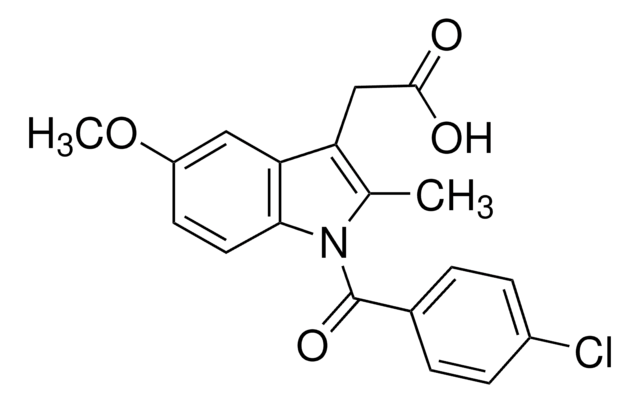405268
Indomethacin
≥98% (HPLC), powder, COX inhibitor, Calbiochem
Synonyme(s) :
Indomethacin, 1-( p-Chlorobenzoyl)-5-methoxy-2-methyl-1H-indole-3-acetic Acid, 1-(p-Chlorobenzoyl)-5-methoxy-2-methyl-1H-indole-3-acetic Acid
About This Item
Produits recommandés
Nom du produit
Indomethacin, A non-steroidal anti-inflammatory, cell permeable, antipyretic agent.
Niveau de qualité
Essai
≥98% (by assay)
Forme
powder
Puissance
740 nM IC50
Fabricant/nom de marque
Calbiochem®
Conditions de stockage
OK to freeze
Couleur
white to off-white
Solubilité
ethanol: 20 mg/mL
Conditions d'expédition
ambient
Température de stockage
10-30°C
InChI
1S/C19H16ClNO4/c1-11-15(10-18(22)23)16-9-14(25-2)7-8-17(16)21(11)19(24)12-3-5-13(20)6-4-12/h3-9H,10H2,1-2H3,(H,22,23)
Clé InChI
CGIGDMFJXJATDK-UHFFFAOYSA-N
Description générale
Actions biochimiques/physiologiques
Avertissement
Autres remarques
Weggen, S., et al. 2001. Nature414, 212.
Kalgutkar, A.S., et al. 2000. Proc. Natl. Acad. Sci. USA97, 925.
Klabunde, T., et al. 2000. Nat. Struct. Biol.7, 312.
Futaki, N., et al. 1994. Prostaglandins47, 55.
Futaki, N., et al. 1994. Prostaglandins47, 55.
Stevenson, K.M., and Lumbers, E.R. 1992. J. Dev. Physiol. 17, 257.
Oliw, E. 1980. Prostaglandins19, 271.
Informations légales
Mention d'avertissement
Danger
Mentions de danger
Conseils de prudence
Classification des risques
Acute Tox. 1 Oral
Code de la classe de stockage
6.1A - Combustible acute toxic Cat. 1 and 2 / very toxic hazardous materials
Classe de danger pour l'eau (WGK)
WGK 3
Point d'éclair (°F)
Not applicable
Point d'éclair (°C)
Not applicable
Certificats d'analyse (COA)
Recherchez un Certificats d'analyse (COA) en saisissant le numéro de lot du produit. Les numéros de lot figurent sur l'étiquette du produit après les mots "Lot" ou "Batch".
Déjà en possession de ce produit ?
Retrouvez la documentation relative aux produits que vous avez récemment achetés dans la Bibliothèque de documents.
Les clients ont également consulté
Notre équipe de scientifiques dispose d'une expérience dans tous les secteurs de la recherche, notamment en sciences de la vie, science des matériaux, synthèse chimique, chromatographie, analyse et dans de nombreux autres domaines..
Contacter notre Service technique







